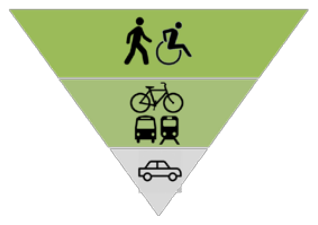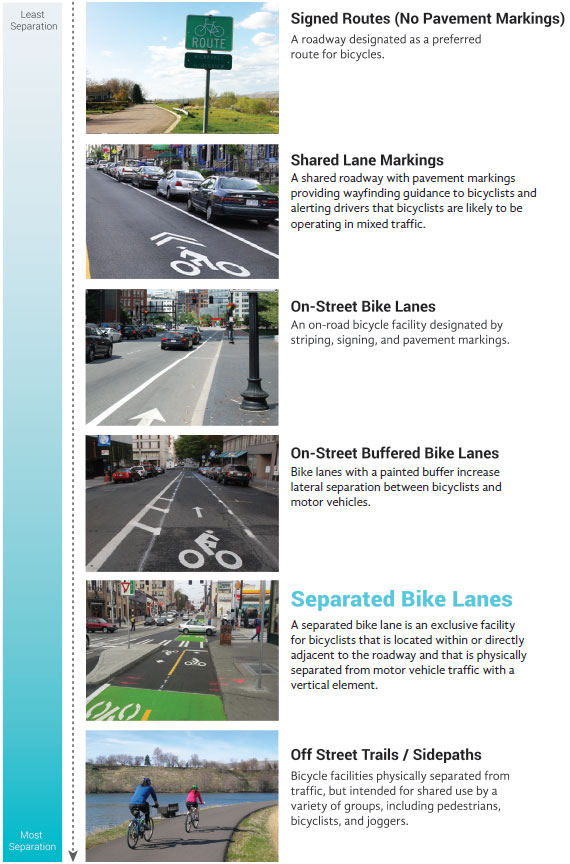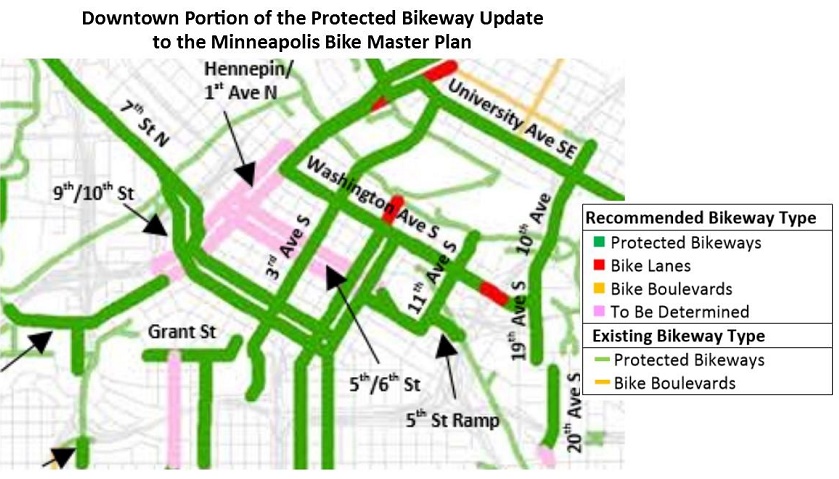Many Recent and Planned Bike Infrastructure Improvements will Benefit Downtown - The Why and How
 Wednesday, August 10, 2016 at 5:02AM |
Wednesday, August 10, 2016 at 5:02AM |  Joan Bennett |
Joan Bennett | Article by Joan Bennett
Bike Improvements Part I
Minneapolis has cultivated a national reputation for exceptional bike infrastructure. The City’s willingness to plan for and invest in bike infrastructure coupled with regional leadership and sophisticated local advocacy groups has resulted in a robust network of off-street and on-street bike pathways. Many of the recent and planned improvements will benefit Downtown. Here’s why and how. A follow-up article will address where Downtown these improvements have been implemented, will be implemented and or are being considered.
Getting Reasonable Adults to Bike
When you think of bike advocacy and infrastructure, you might assume that middle aged men in Lycra (referred to as MAMILs bike policy circles) or hipsters with still-forming frontal lobes are the target constituency. While it may have started that way, cycling is no longer just a hobby, but its expansion a critical piece of urban livability and environmentally sound transit planning. The goal is now to encourage the broad adoption cycling.
This means courting appropriately cautious adults, whose brains wisely register the risk of biking amidst urban traffic (unlike this guy) through infrastructure improvements that convince this group that cycling can be reasonable and comfortable mode of transportation. Therefore, it is important to note that not only is the bike network expanding, it’s becoming safer as planners learn from past mistakes and successes. (For example, you might remember the bike lane on Hennepin that funneled cyclists into oncoming traffic? It has since been redesigned with more robust improvements under consideration for 2020.)
It’s Not Just About Bikes: The Complete Streets Movement Seeks to Improve Streets for Diverse Uses
Though Minneapolis’ bike planning well precedes the City’s formal commitment to “complete streets”, one cannot discuss current bike infrastructure planning without nesting it within the “complete streets” paradigm. (View the Complete Streets Policy adopted by Minneapolis City Council this spring.)
 “Complete streets” planning calls for cities to redesign streets to balance the needs of automobiles, transit-users, cyclists and pedestrians. Under “complete streets”, the car takes a subordinate position to the safety and comfort of pedestrians and cyclists/transit- users. In Minneapolis, though not all streets will provide special accommodation for all types of uses, all transportation planning decisions will need to weigh the needs of pedestrians, cyclists and transit users in addition to cars.
“Complete streets” planning calls for cities to redesign streets to balance the needs of automobiles, transit-users, cyclists and pedestrians. Under “complete streets”, the car takes a subordinate position to the safety and comfort of pedestrians and cyclists/transit- users. In Minneapolis, though not all streets will provide special accommodation for all types of uses, all transportation planning decisions will need to weigh the needs of pedestrians, cyclists and transit users in addition to cars.
This paradigm shift will play out over time. When streets are up for regularly scheduled for reconstruction or maintenance, the planned improvements will have to prioritize pedestrians, bikes and transit (when along a transit route) or planners will need to make strong case as to why that street should be exempt from the Complete Streets Policy.
Honoring the difficulty of implementing “complete streets” the City hired an experienced transportation planner, the first non-engineer to lead the department, who specializes in working across transit projects and improving conditions for bike and pedestrians as its new Public Works Director.
How are bike advocates leveraging “complete streets” planning?
Many bike advocates argue that, when done correctly, design that improves streets for cyclists can improve conditions for pedestrians and other interests. Rather than a single-minded focus on cyclists, there is a growing “rising tide lifts all boats” mentality among activists and planners.
Some studies have found that reducing the space allocated to auto traffic to accommodate bike lanes can mitigate car congestion. A traffic study conducted in New York City Department of Transportation found that streets with protected bike lanes also saw a reduction in pedestrians collisions with cars. Further, creating a separation between storefronts and auto traffic through bike and pedestrian infrastructure can improve conditions for restaurants and retail.
Minneapolis Bike Master Plan
A long established Minneapolis Bike Master Plan guides the implementation of bike infrastructure. The plan outlines a set of priorities for expanding and linking bike infrastructure throughout Minneapolis. The Master Plan serves as a guide, but the implementation is at the discretion of the Mayor and City Council. Therefore, an anti-bike City Hall could put the brakes on things.
When the time comes to implement infrastructure, City staff work with local business and neighborhood groups to refine the design. The City also coordinates with the Minneapolis Park Board, Hennepin County, Met Council and State Department of Transportation, who all have their own master plans/policy priorities that govern bike trails and infrastructure. Even the Federal Highway Administration also has an interest in bike lanes.
The Bike Infrastructure Spectrum
Planners select a route and apply “treatment” based on the volume of traffic and degree of danger posed to cyclists, wiggle room to add infrastructure, and, of course, the budget. Treatments are typically organized in terms of how much separation they provide between cyclists and motorized traffic. People for Bikes have prepared an excellent graphic that provides an overview of bike infrastructure options. These range from icons and lines painted on the street to various iterations of protected on-street bike lanes to physically separated trails.

Image Source: People for Bikes
Protected Bike Lanes Are Hot Right Now, Particularly Downtown
Pragmatic advocates of cycling often argue that to reduce our reliance on cars, you first need to make the alternatives safer and more attractive. (This approach also serves an equity and social justice goal by improving conditions for people for whom automobile ownership is out of reach.)
The most effective way to get reasonable, cautious adults to bike is by creating separated bikeways (i.e. Midtown Greenway or the Grand Rounds). When that is not possible, a protected on-street bike lane is the next best solution. A protected bike lane physically separates the bike lane from automobile traffic through any number of methods such as plastic bollards, planters or a parking lane.
A recent study out of Portland State found that protected bike lanes increase bike traffic by 21% to 171% on various routes. The same study also found the protected bike lanes significantly reduced collisions or near-collisions. When designed well, protected bike lanes also carry a host of safety benefits for pedestrians in addition to reducing the number of cyclists who illegally opt to use the sidewalk.
The City is doubling down on bike lanes. The City’s Climate Action Plan calls for 30 miles of protected bike lanes by 2025. To implement this, a Protected Bikeway Update to the Master Plan calling specific routes and priorities for on-streets protected bike lanes was adopted in 2015.

What’s Underway Downtown?
A number of bike projects are underway, have been cued up for implementation in 2017 or are in active planning stages. The next article in series will address those.
Joan Bennett is staff with the Downtown Minneapolis Neighborhood Association and the Corcoran Neighborhood Organization. The views expressed in this article do not necessarily reflect those of either organization.
Joan can be reached at joan@millcitymedia.org
